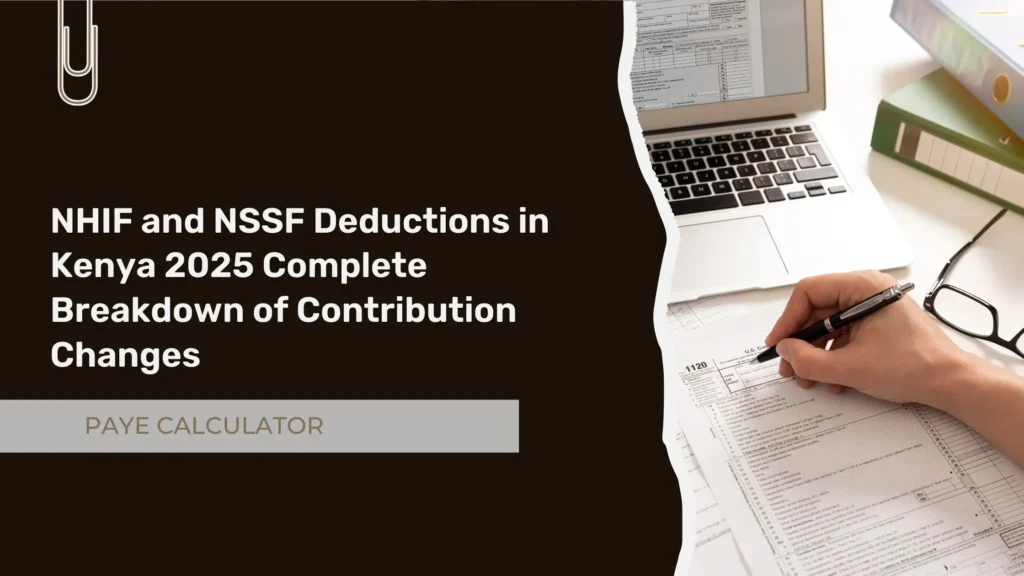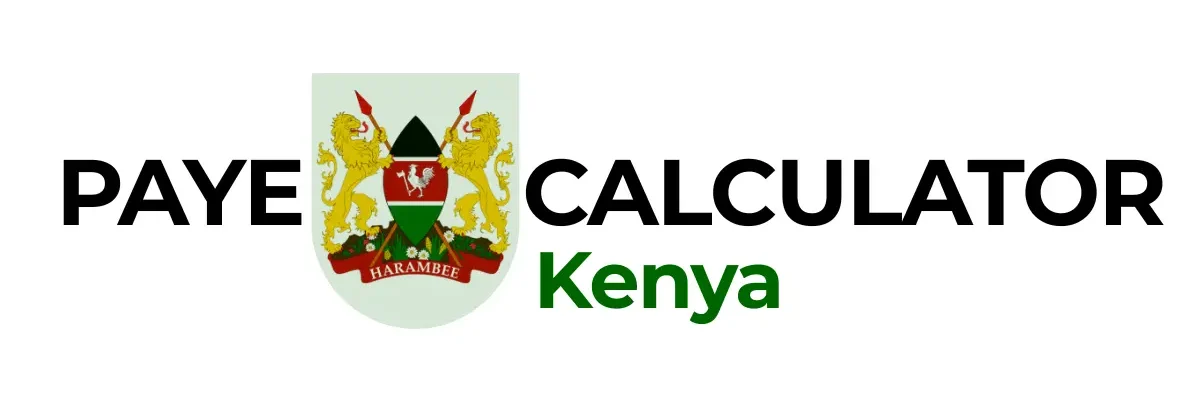Title: NHIF and NSSF Deductions in Kenya 2025 Complete Breakdown of Contribution Changes
In 2025, Kenyan employees and employers are adjusting to significant updates in statutory deductions. The National Hospital Insurance Fund (NHIF) and the National Social Security Fund (NSSF) have both undergone changes to strengthen healthcare access and retirement benefits.
These updates affect every working Kenyan whether you are an employer processing payroll or an employee reviewing your payslip. This article explains the new NHIF and NSSF deductions in Kenya 2025, how they are calculated, and what they mean for your salary and long-term financial planning.

Understanding NHIF
The National Hospital Insurance Fund (NHIF) is a mandatory health insurance scheme that provides medical cover for Kenyans working in both formal and informal sectors. It helps citizens access inpatient and outpatient healthcare services across public and private hospitals.
Key points about NHIF:
- It is managed by the Ministry of Health.
- It provides benefits including inpatient and outpatient services, maternity, dialysis, and surgeries.
- Both employees and self-employed persons contribute monthly.
NHIF plays a crucial role in ensuring that all Kenyans have access to affordable healthcare, especially under the government’s universal health coverage program.
Understanding NSSF
The National Social Security Fund (NSSF) is Kenya’s main retirement savings scheme. It allows employees to save a small portion of their monthly income for use after retirement. Both employers and employees contribute to the fund every month.
Key points about NSSF:
- It is managed by the Ministry of Labour and Social Protection.
- Both the employer and employee contribute an equal share.
- The funds provide retirement, survivors, and invalidity benefits.
The government has been gradually increasing NSSF contribution rates under the NSSF Act No. 45 of 2013 to help Kenyans build stronger retirement savings.
NSSF Contribution Changes in 2025
Under the NSSF Act 2013, the contribution system is divided into two categories: Tier I and Tier II. The aim is to replace the old flat-rate system of KSh 200 per month with a percentage-based contribution that grows with income.
As of January 2025, the updated structure is as follows:
Tier I – Lower Earnings Limit
- Applies to employees earning up to KSh 7,000 per month.
- Contribution rate: 6% of gross salary.
- Both employer and employee contribute equally.
- Maximum deduction per side: KSh 420 (total KSh 840).
Tier II – Upper Earnings Limit
- Applies to employees earning between KSh 7,001 and KSh 36,000.
- Contribution rate: 6% on the amount above KSh 7,000.
- Maximum deduction per side: KSh 1,740 (total KSh 3,480).
Total maximum NSSF deduction for 2025:
KSh 2,160 (KSh 1,080 by employee + KSh 1,080 by employer).
Example of NSSF Deduction in 2025
| Monthly Salary (KSh) | Employee Deduction (6%) | Employer Deduction (6%) | Total Contribution |
|---|---|---|---|
| 10,000 | 600 | 600 | 1,200 |
| 20,000 | 1,020 | 1,020 | 2,040 |
| 36,000 | 1,080 | 1,080 | 2,160 |
Employers must remit both their share and the employee’s share to the NSSF by the 15th day of every month. Late submissions attract penalties.
Why the NSSF Rates Increased
The revised NSSF rates are part of the national Social Security Reforms Programme. The goal is to help workers build stronger retirement savings and ensure that future pensions are meaningful and sustainable.
Under the old flat-rate system, most workers retired with very low savings. The new tier-based percentage system ensures that contributions are proportional to income, leading to better retirement benefits.
NHIF Contribution Structure in 2025
NHIF continues to operate under its existing structure while preparing for the transition to the new Social Health Insurance Fund (SHIF). The SHIF aims to expand access and efficiency in Kenya’s healthcare financing system.
Until then, NHIF contributions remain as follows:
| Monthly Gross Pay (KSh) | NHIF Deduction (KSh) |
|---|---|
| 0 – 5,999 | 150 |
| 6,000 – 7,999 | 300 |
| 8,000 – 11,999 | 400 |
| 12,000 – 14,999 | 500 |
| 15,000 – 19,999 | 600 |
| 20,000 – 24,999 | 750 |
| 25,000 – 29,999 | 850 |
| 30,000 – 34,999 | 900 |
| 35,000 – 39,999 | 950 |
| 40,000 – 44,999 | 1,000 |
| 45,000 – 49,999 | 1,100 |
| 50,000 – 59,999 | 1,200 |
| 60,000 – 69,999 | 1,300 |
| 70,000 – 79,999 | 1,400 |
| 80,000 – 89,999 | 1,500 |
| 90,000 – 99,999 | 1,600 |
| 100,000 and above | 1,700 |
These deductions are directly taken from the employee’s gross salary each month.
Difference Between NHIF and NSSF
| Feature | NHIF | NSSF |
|---|---|---|
| Purpose | Provides medical coverage | Provides retirement benefits |
| Managed by | Ministry of Health | Ministry of Labour |
| Contribution Type | Fixed amount based on salary range | Percentage of salary (6%) |
| Who Pays | Employee (mandatory) | Employer and employee (equal share) |
| Benefit Type | Health and medical services | Pension and social security |
Example of a Payslip with NHIF and NSSF Deductions
Let’s take an employee earning a gross monthly salary of KSh 30,000:
| Description | Amount (KSh) |
|---|---|
| Gross Salary | 30,000 |
| NSSF (6%) | 1,080 |
| NHIF | 900 |
| PAYE (Approx.) | 2,500 |
| Net Pay | 25,520 |
This shows how statutory deductions directly affect your take-home pay. It is important for both employers and employees to understand these figures to plan better for monthly budgets.
Benefits of NHIF and NSSF Reforms
- Enhanced retirement savings:
The increased NSSF rates help workers build more meaningful pension savings for old age. - Improved healthcare coverage:
NHIF reforms aim to make healthcare more affordable and accessible to every Kenyan. - Digital systems for accountability:
Both NHIF and NSSF have adopted online payment and verification systems for better transparency. - Balanced contribution model:
Employers and employees share the responsibility equally, reducing financial strain on one side.
Penalties for Late Remittance
Employers who fail to submit contributions on time face stiff penalties.
NHIF: 5% of the amount due for every month delayed.
NSSF: 5% of the amount due or KSh 1,000, whichever is higher.
Employers are advised to remit all statutory payments before their respective deadlines to avoid legal action and fines.
How to Check NHIF and NSSF Contributions
For NHIF:
- Visit the NHIF Self-Care Portal at https://selfcare.nhif.or.ke.
- Log in using your ID or mobile number.
- View your payment history and hospital access details.
For NSSF:
- Go to https://nssf.go.ke.
- Log in to your member account.
- Check your monthly contributions and statements.
Regularly checking your contribution status ensures your records are up to date and protects your benefits.
What Employees and Employers Should Do in 2025
- Stay informed about all official circulars from NHIF and NSSF.
- File PAYE and statutory returns before their deadlines.
- Educate staff on the importance of the new contribution system.
- Use payroll calculators or online tools to confirm deductions.
Websites like payecalculatorkenya.pro provide free and reliable calculators for employees and HR teams to estimate their deductions accurately.
Conclusion
The NHIF and NSSF deduction changes in Kenya 2025 reflect a major step towards improving the welfare of Kenyan workers. While the increased contributions may slightly reduce take-home pay, they guarantee stronger healthcare coverage and better financial security after retirement.
Both employees and employers should view these deductions as a long-term investment in stability and wellbeing. Staying compliant not only keeps your organization within the law but also builds a safer and more sustainable workforce for Kenya’s future.
